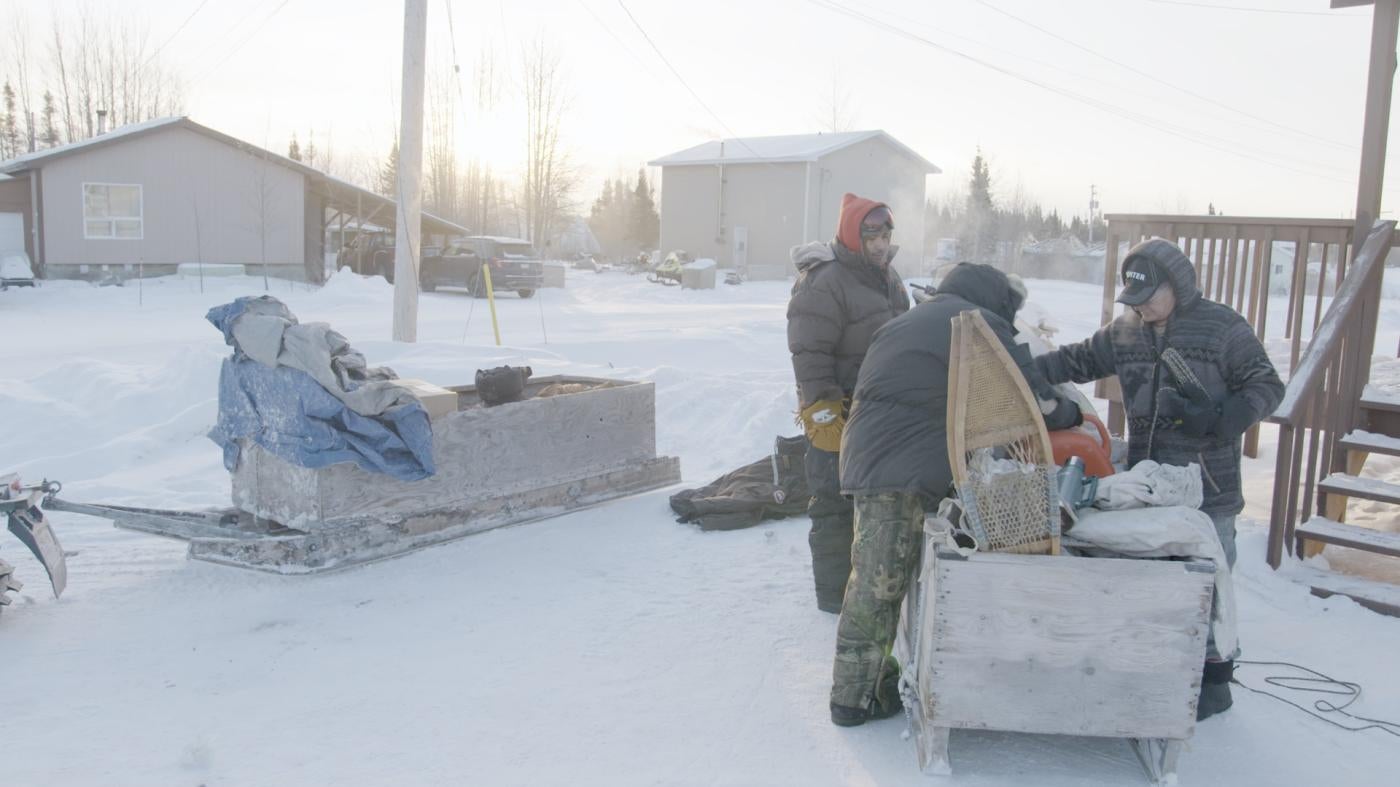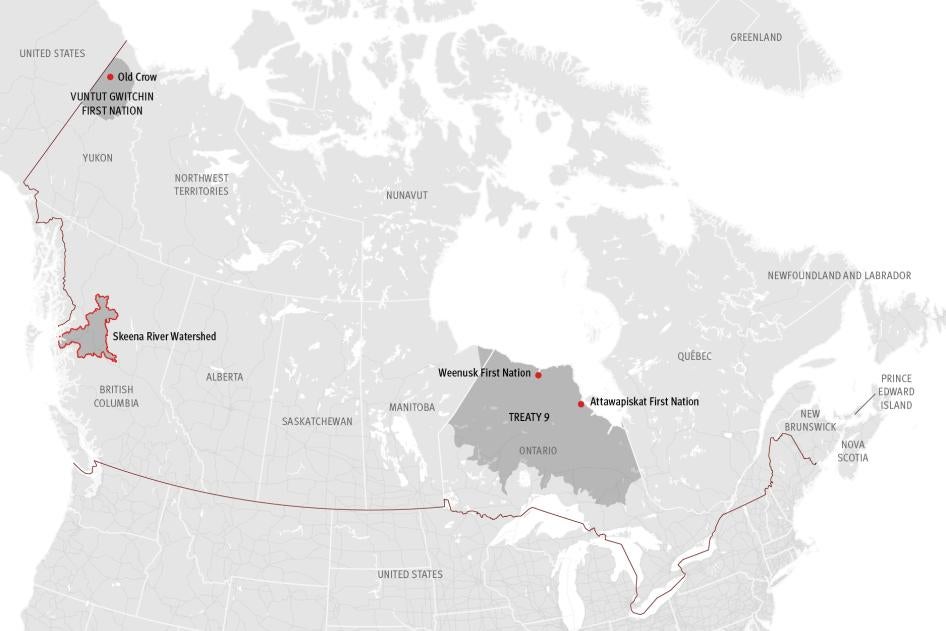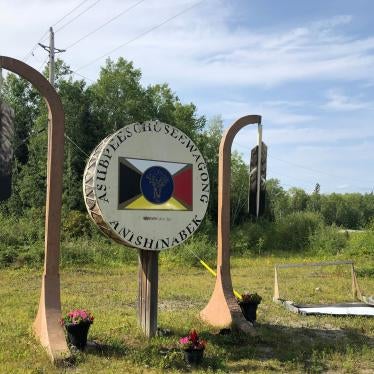Can you tell me more about what you found researching this report?
We visited First Nations in Ontario, the Yukon, and British Columbia, and spoke with community members about how climate change is impacting their ability to harvest traditional foods, such as caribou, fish, moose, and geese; and how they are coping, given that warming temperatures make it harder to access these foods in sufficient quantity to feed their families. Because traditional food sources are becoming less available and accessible, they rely more on food they can buy in the store, which is a challenge in remote communities where store-bought food, especially nutritious and healthy food, is prohibitively expensive or not available.
The impacts of climate change extend to limiting communities’ ability to purchase food alternatives in stores to supplement harvested foods. Food is brought into the communities via seasonal winter roads and that is harder as winters become shorter and the freezing temperatures that make it possible to build winter roads across permafrost and frozen waterways become less reliable. If food cannot be transported by winter roads, it must be flown in, which raises food prices further.
So climate change is exacerbating food poverty, which is already high among Indigenous peoples due to historic discrimination. As Canada continues to warm by two to three times the global rate, First Nations people that have historically struggled with low incomes, food poverty, and health issues directly tied to the legacy and ongoing discrimination of colonialism, are now in a situation where things are getting worse quickly.
What was it like to visit these communities?
Each community I visited was a unique experience, but there are certain commonalities; the difficulty and high cost of travelling to remote communities being one. Another similarity is the way in which each First Nation described the importance of their relationship to their traditional lands.
The Old Crow community, for example, is part of the Vuntut Gwitchin First Nation in Canada’s Yukon territory, situated just above the Arctic Circle. When I visited them, I arrived after many hours in a tiny airplane at the airport — where there are usually a few people waiting with Ski-Doos, a type of snowmobile and the main method of transportation in the winter. The Porcupine River, which has huge significance for hunting, fishing, and travel, flows through the community. I spent time walking with community members, listening to them describe their relationship to the land. They have lived in the area for generations and follow in their ancestors’ footsteps to find certain traditional foods. This connection was clear when community members told me about the transformations they are witnessing because of climate change: it’s as though the land is their house, where they know every corner.
The issue now is about so much more than just the food they have on the table, but about their identity and culture.
And how are their lives now changing?
The Old Crow community has seen water levels in the river drop in recent years because of rising temperatures. Warmer water has meant the depletion of certain fish species that First Nations people depend on to feed their families. Other species they traditionally hunt, like caribou, which would normally sustain their families for months during the winter, are now harder to access, in part because of environmental change. As these resources decrease, the community deliberately takes in less from the land to ensure plentiful stock the following season, and as a result have less to live on for the remainder of the year.
Access is also an issue. It is harder or sometimes impossible to get to some hunting areas as warmer and fluctuating temperatures make it more dangerous to travel on the ice. They have unfortunately had cases of community members falling through the ice, so hunting during certain months can be a huge risk.
When they get less food from the land, people increasingly rely on store-bought foods. But because of the high cost of many items, they are forced to cut back or buy what is cheapest – which are often the less healthy options. This is a big concern in all remote communities we visited, especially as many First Nations people already experience exceptionally high rates of chronic health conditions such as diabetes, which require a specific diet that becomes unattainable on a low-income budget. Research shows that maintaining a diet of traditional foods can help protect against diabetes.
How has the Canadian government been contributing to this crisis?
Canada is still among the world’s top ten greenhouse gas emitters and is not on track to meet its own greenhouse gas emissions reduction goals under the Paris Agreement. Even if it did, its commitments to mitigate climate change would not be enough to keep global temperature rise below 1.5 degrees Celsius. Meanwhile, we are already seeing dramatic effects on Indigenous peoples, who contribute very little to Canada’s emissions, yet are among the most exposed to climate impacts in the country.
Is the government doing anything to address this?
The federal government has been saying all the right things on climate change and protecting Indigenous peoples’ rights, and there has been some progress. But the impacts of the climate crisis on Indigenous food poverty are still largely unaddressed and First Nations do not get the support they need to adapt to climate change. One thing we noticed is there is very little monitoring being done in First Nations communities to assess the effect of climate change on food and health. So that is concerning because it’s basically impossible to address the impacts if they don’t know what’s going on in the communities. The government has implemented some policies to address food insecurity, but these often do not reach the community members that need it the most. And growing problems impacting the land and environment around these communities, like the ones we document in this report, are just not addressed.
How are the communities themselves responding to the threat?
It was deeply humbling for me to see how First Nations people are connected to the land and what that means for their vision of sustainability and being leaders on climate change. These communities know they have an important role because they understand how to protect the land. The Old Crow community, for example, led an effort among First Nations to declare a national climate emergency and managed to develop a solar power plant in their community. Other communities are documenting changes to their land and bringing that data to the government.
In British Columbia, I visited several communities along the Skeena River, where the First Nations culture is closely tied to fish, mainly salmon. I met with Hereditary Chiefs there, who are responsible for taking care of the land. They are seeing impacts on the river from climate change as well as other threats, like logging. They showed me several spots on the river where they are monitoring fish populations in order to issue alerts to the communities when they see signs of population decrease. And in years when there are less fish, they won’t take them. It’s a sign of adaptation and recognition of the importance of the land’s survival that could really serve as a model for the rest of the country.
What happens next?
These communities are good at adapting to changing conditions. They have done so for generations and are doing it now in the context of climate change. Their strong culture and connection to the land is what makes them so resilient. But it is concerning to see these communities, already confronted with so much oppression and discrimination over the past decades, not get the support they need from government when facing new threats from the climate crisis. Some people I met with told me they are not certain whether they can sustain their way of life much longer.
The Canadian government has made commitments to do better but is still lacking a consistent and comprehensive strategy. Policies need to include Indigenous-led solutions that will benefit these communities in the long-term. And globally, the government needs to scale up its efforts and implement a plan that is at least going to meet international standards on climate change, including major lowering of greenhouse gas emissions, to mitigate its effects and protect those communities facing the most acute threats.
*This interview has been shortened and condensed






